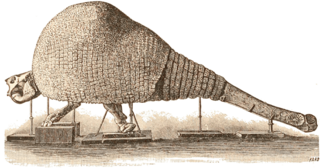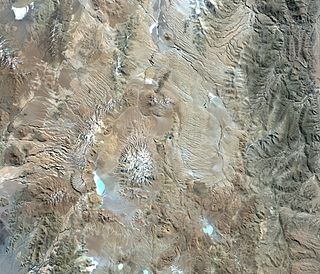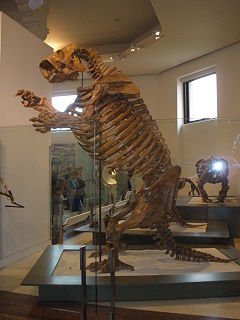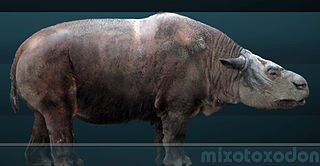 W
WArctotherium is an extinct genus of Pleistocene South American short-faced bears within Ursidae. Their ancestors migrated from North America to South America during the Great American Interchange, following the formation of the Isthmus of Panama during the late Pliocene. The oldest dated confirmed remains are those of A. angustidens from Buenos Aires, Argentina, dating to the Ensenadan epoch, 1.76 to 0.98 Ma old, within the Early to Middle Pleistocene, with a tooth possibly belonging to Arctotherium dating about 2.588 Mya. They are genetically closer to the spectacled bear, than to Arctodus of North America, implying the two extinct forms evolved large size in a convergent manner, perhaps to facilitate dominating other carnivores in the competition for the biggest carcasses. The northernmost species, A. wingei, known from Venezuela in South America, apparently invaded Central America and reached as far north as the Yucatán.
 W
WCarletonomys cailoi is an extinct rodent from the Pleistocene (Ensenadan) of Buenos Aires Province, Argentina. Although known only from a single maxilla with the first molar, its features are so distinctive that it is placed in its own genus, Carletonomys. Discovered in 1998 and formally described in 2008, it is part of a well-defined group of oryzomyine rodents that also includes Holochilus, Noronhomys, Lundomys, and Pseudoryzomys. This group is characterized by progressive semiaquatic specializations and a reduction in the complexity of molar morphology.
 W
WDoedicurus, or Dædicurus, is an extinct genus of glyptodont from South America containing one species, D. clavicaudatus. Glyptodonts are a member of the family Chlamyphoridae, which also includes some modern armadillo species, and they are classified in the order Xenarthra alongside sloths and anteaters. Being a glyptodont, it was a rotund animal with heavy armor and a carapace. Averaging at an approximate 1,400 kg (3,100 lb), it was one of the largest glyptodonts to have ever lived. Though glyptodonts were quadrupeds, large ones like Doedicurus may have been able to stand on two legs like other xenarthrans. It notably sported a spiked tail club, which may have weighed 40 or 65 kg in life, and it may have swung this in defense against predators or in fights with other Doedicurus at speeds of perhaps 11 m/s.
 W
WDusicyon avus is an extinct species of canid in the genus Dusicyon. It was medium to large, about the size of a German shepherd.. It was closely related to the warrah or Falkland Islands wolf, and was the ancestral species from which it diverged. It appears to have survived until very recently, perhaps 400 years ago.
 W
WCerro Galán is a caldera in the Catamarca Province of Argentina. It is one of the largest exposed calderas in the world and forms part of the Central Volcanic Zone of the Andes, one of the three volcanic belts found in South America. One of several major caldera systems in the Central Volcanic Zone, the mountain is grouped into the Altiplano–Puna volcanic complex.
 W
WGlossotherium was a genus of ground sloth. It was a heavily built animal with a length of about 4 metres (13 ft) snout to tail-tip, a weight estimated at 1,000 kg (2,200 lb), and could potentially assume a slight bipedal stance.
 W
WGlyptodon was a genus of large, heavily armored mammals of the subfamily Glyptodontinae – relatives of armadillos – that lived during the Pleistocene epoch. It was roughly the same size and weight as a Volkswagen Beetle. With its rounded, bony shell and squat limbs, it superficially resembled a turtle, and the much earlier dinosaurian ankylosaur – providing an example of the convergent evolution of unrelated lineages into similar forms. In 2016 an analysis of Doedicurus mtDNA found it was, in fact, nested within the modern armadillos as the sister group of a clade consisting of Chlamyphorinae and Tolypeutinae. For this reason, glyptodonts and all armadillos but Dasypus were relocated to a new family, Chlamyphoridae, and glyptodonts were demoted from the former family Glyptodontidae to a subfamily.
 W
WThis is a list of gomphothere fossils found in South America. Gomphotheres were elephant-like mammals that lived from the Middle Miocene to the Holocene.
 W
WHemiauchenia, synonym Tanupolama, is a genus of lamine camelids that evolved in North America in the Miocene period about 10 million years ago. This genus diversified and moved to South America in the Early Pleistocene, as part of the Great American Biotic Interchange, giving rise to modern lamines. The genus became extinct at the end of the Pleistocene.
 W
WHippidion is an extinct genus of horse that lived in South America from the Late Pliocene to the end of the Late Pleistocene (Lujanian), between two million and 11,000 years ago. They were one of two lineages of equines native to South America during the Pleistocene epoch alongside those of the Equus subgenus Amerhippus.
 W
WHolmesina is a genus of pampathere, an extinct group of armadillo-like creatures that were distantly related to extant armadillos. Like armadillos, and unlike the other extinct branch of megafaunal cingulates, the glyptodonts, the shell was made up of flexible plates which allowed the animal to move more easily. Holmesina species were herbivores that grazed on coarse vegetation; armadillos are mostly insectivorous or omnivorous.
 W
WLestodon is an extinct genus of megafaunal ground sloth from South America during the Pliocene to Pleistocene periods. Its fossil remains have been found in Argentina, Paraguay, Uruguay, Venezuela, Bolivia, and Brazil. Measuring approximately 4.6 metres (15 ft) from snout to tail tip, it is estimated to have weighed 2,590 kilograms. It was a herbivore and primarily fed on the grasses on the South American plains and is thought to perhaps have used its semi-bipedal stance to obtain foliage from trees. Lestodon is placed as member of the Mylodontidae as indicated by the lobed form of the last tooth in the dentition.
 W
WThe last glacial period and its associated glaciation is known in southern Chile as the Llanquihue glaciation. Its type area lies west of Llanquihue Lake where various drifts or end moraine systems belonging to the last glacial period have been identified. The glaciation is the last episode of existence of the Patagonian Ice Sheet.
 W
WLomaphorus is an extinct genus of glyptodont that lived during the Pleistocene in eastern Argentina. Fossils of the genus were found in the Lagunilla del Plata Formation.
 W
WMacrauchenia was a large, long-necked and long-limbed, three-toed native South American mammal in the order Litopterna. The genus gives its name to its family, the Macraucheniidae or "robust litopterns". Like other litopterns, it is not closely related to any living mammal, being most closely related to the group containing horses, rhinos and tapirs, from which litopterns diverged approximately 66 million years ago. The oldest fossils in the genus date to the late Miocene, around seven million years ago, and M. patachonica disappears from the fossil record during the late Pleistocene, around 20,000-10,000 years ago. M. patachonica is one of the last and best known member of the family and is known primarily from the Luján Formation in Argentina, but is known from localities across southern South America. Another genus of macraucheniid Xenorhinotherium was present in northeast Brazil and Venezuela during the Late Pleistocene. The type specimen was discovered by Charles Darwin during the voyage of the Beagle. In life, Macrauchenia may have resembled a humpless camel, though the two taxa are not closely related. It fed on plants in a variety of environments across what is now South America. Among the species described, M. patachonica and M. ullomensis are considered valid; M. boliviensis is considered a nomen dubium; and M. antiqua has been moved to the genus Promacrauchenia.
 W
WMesotherium, synonym, "Typotherium," is the type genus of Mesotheriidae, a long-lasting family of superficially rodent-like, burrowing notoungulates from South America. It was first named by Étienne Serres in 1867, and through further finds now contains four species, M. cristatum, M. hystatum, M. maendrum, and M. pachygnathum. Fossils have been found in the Miramar and Vorohué Formations of Argentina.
 W
WMixotoxodon is an extinct genus of notoungulate of the family Toxodontidae inhabiting South America, Central America and parts of southern North America during the Pleistocene, from 1,800,000—12,000 years ago.
 W
WMylodon is an extinct genus of ground sloths that lived in South America; Patagonia. The most recent credible date obtained from its remains has been reported to be 10,200 BP.
 W
WNeolicaphrium is an extinct genus of ungulate mammal belonging to the extinct order Litopterna. This animal lived from the Late Pliocene (Chapadmalalan) to the Late Pleistocene (Lujanian) in southern South America, being the last survivor of the family Proterotheriidae.
 W
WNeosclerocalyptus was an extinct genus of glyptodont that lived during the Pleistocene in northeastern Argentina.
 W
WPanochthus is an extinct genus of glyptodont, which lived in the Gran Chaco-Pampean region of Argentina, Brazil, Bolivia, Paraguay and Uruguay during the Pleistocene epoch.
 W
WPlatygonus is an extinct genus of herbivorous peccaries of the family Tayassuidae, endemic to North and South America from the Miocene through Pleistocene epochs, existing for about 10.289 million years .
 W
WThe Río Cuarto craters are a purported group of impact craters located in Córdoba Province, Argentina. Research published in 2002 indicates that they are more likely a result of Aeolian processes.
 W
WScelidodon is an extinct genus of South American ground sloths. Its remains have been found in the Yupoí and Uspara Formations of Argentina, the Ulloma, Umala, Ñuapua and Tarija Formations of Bolivia, in Brazil, in Chile and in Peru. The youngest fossils have been dated to as recently as 9000 B.P.
 W
WScelidotherium is an extinct genus of ground sloth of the family Scelidotheriidae, endemic to South America during the Late Pleistocene epoch. It lived from 780,000—11,000 years ago, existing for approximately 0.67 million years .
 W
WSclerocalyptus was a glyptodont that lived during the Pleistocene in Argentina. Four species are described from the Ensenadan, S. pseudornatus, S. ornatus, S. perfectus and S. cordubensis, and two Lujanian taxa S. heusseri and S. evidens.
 W
WTheriodictis is an extinct genus of small hypercarnivorous fox-like canid endemic to South America during the Pleistocene, living from 1.2 Ma- 500,000 years ago and existing for approximately 0.7 million years .
 W
WToxodon is an extinct genus of South American mammals from the Late Miocene to early Holocene epochs. It is a member of Notoungulata, one of several now extinct orders of hoofed mammals indigenous to South America. It was among the largest and last members of its order, and was probably the most common large hoofed mammal in South America of its time.